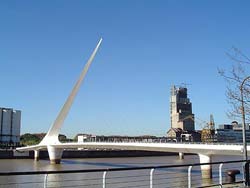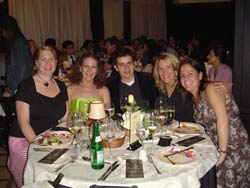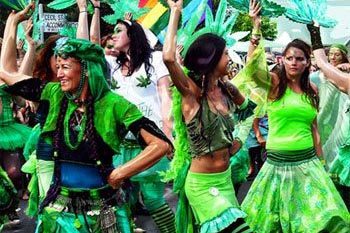
By Sony Stark
The seasons are reversed in Argentina but that hasn’t stopped travelers from flocking to the fabled ‘Paris of the South’ or Buenos Aires. The devalued peso in 2021, good for us — bad for them, is burgeoning a whole new boom in travel destinations throughout the country.
Wander aimlessly to the pulsating rhythms of tango in the barrios (neighborhoods). Feast on a plate of succulent beef at a famous Asado (family-style barbeque). Browse for leather bargains in the friendly pedestrian mall on Calle Florida (Florida Street).
The money saved here is enough to fly home first class. And don’t worry about your limited Spanish — sometimes a friendly gesture and a trusted map are all you need to make friends with a beautiful porteño (local). So, walk it, bus it, cab it but be aware that the sophisticated old charm of Buenos Aires is only skin deep. This Latin city is still struggling from a high post-crisis unemployment rate.
Bust to Boom
Only a few years ago the country crumbled into economic bankruptcy and serious social disorder. Decades of international borrowing and government corruption (tax evasion, money laundering) culminated in nearly half a million Argentines dying of hunger between 1990 and 2003.
But as Buenos Aires quietly crawls back from years of high inflation and unemployment rates, President Alberto Fernandez, elected in 2019, has vowed to make things better.

Honest Work in Buenos Aires
For proof of this, there are two professions you’ll encounter in Buenos Aires long before your bags are unpacked: paseaperros or professional dog-walkers and cartoneros or garbage recyclers.
My first meet and greet was not with a señor but a Shetland Sheepdog. Like in Paris, dog-walkers crowd the sidewalks tugging away at as many as 15 canines at a time. The pay is decent and if you’re a natural dog lover like me, it’s hardly considered work. By the way, watch where you step…
Cartoneros, on the other hand, toil day and night in the dirtiest job I can imagine. Middle-class construction workers, office personnel, and even farmers turned to collect recyclables to eke out a living when times got tough.
The number of cartoneros isn’t as high as it was in 2003 but 10,000 of them still scrape by picking up glass, cardboard, and plastic and delivering it to waste stations.
On the plus side, the results yield tremendous environmental benefits for the city– curbing landfill amounts and keeping the streets clean. Also, recently, the government passed a cooperative registration system improving the working conditions and resale value of recyclables.
Knowing the financial history of Argentina and the people that make it so special is a gentle reminder not to take advantage of the exchange rate. A genuine leather wallet priced for 15 pesos (five dollars) is already a bargain without having to barter. A couple of extra dollars go a lot further in their hands than ours.
Safety in Numbers
There are 87 barrios in a city of 15.1 million and those surrounding the city center are the most visited. If you’re able to find a hotel in Retiro, as I did, surrounding barrios like Puerto Madero, Recoleta, and Monserrat are all within 20 minutes by foot. Others, like La Boca and Mataderos, are a 20-minute cab ride or further using the bus lines. If you enjoy ‘people watching’ and have the time, ask about mass transportation – like the subway system or bus services.

A hotel concierge will discourage it but I found a 33-cent trip to the outskirts of the city safe, friendly and reliable. As always, be cautious about your possessions –petty theft is hardly a concern but it does happen.
Buenos Aires is A Vegetarian’s Worst Nightmare
Puerto Madero is the youngest barrio and caters to a lively social scene made up of discos, high-end restaurants, and expensive office space. A bold transformation began 10 years ago with the gutting of 16 brick warehouses and transforming them into the trendiest places in town.
The promenade and pedestrian bridge Puente de la Mujer (identical to a boomerang) are wide enough for skaters, bicycles, strollers and even cows to navigate.

The last place a tourist should ever consider is an American chain restaurant. Of course, there are plenty of other cosmopolitan cuisines too. From sushi to pizza to gnocchi, flavors from all over the world are as common in this country as their own.
But the crowning glory is no doubt a juicy steak at the parrilla (grill restaurant) called Cabaña Las Lilas. It’s a little pricey for the Argentine fare but well worth it.
I enjoyed the Tail of Rump chased by a bottle of their best red. The restaurant’s been breeding bulls and fathering calves for 70 years in the Pampean grasslands. They even prepare the meat you order in public, cook it on flaming grills behind glass windows for you, the customer to watch.
Traditionally, dining time in Argentina doesn’t begin until 10 pm but this place is usually full by 7 pm. Go early or expect lines.
Sweet Dreams
Lined with antiques, art, and yerba mate cafes (loose green tea drank in hollowed-out gourds) Retiro is the ideal barrio to find a good night’s sleep. And if you’re looking to ‘do it up’ right, the prestigious five-star Sofitel Hotel is the place to stay. This landmark hotel sits on a tight cobblestone street (Arroyo str.) surrounded by balconied buildings and deep, narrow lots.

It was once Buenos Aires’ highest building but today the owners can boast about preserving its 1890’s facade in a glass atrium with an enormous wrought-iron chandelier hanging over the front desk. Historic preservation is a beautiful thing and there’s plenty of it in Buenos Aires.
Glass and Class
With the Sofitel Hotel, it’s both glass and class all the way. Each room is decorated with flower arrangements, potpourri scents and in the evening, a floating candle in a clear square vase of rose petals is placed next to your sunken tub.
Before bedtime, a generous portion of truffles and cherry cordials are hand-delivered on a silver platter. I gained 3 pounds on that alone. It’s also worth noting that the Sofitel ranks #3 in a popularity index of 168 hotels in Buenos Aires on tripadvisor.com.
In the morning, another nice touch is the Buenos Aires Herald newspaper, the oldest English-language daily in Latin America, dropped at your door. The two connecting restaurants, Café Arroyo and Le Sud offer simple, elegant cooking by the country’s top Parisian chefs with the friendly wait staff I’ve ever had.
No Rest for the Weary
“Falling in love is the right adventure for those who dislike sports and travel.”

I’m not sure who coined the expression but I suggest using it when you find yourself attracted to an Argentine guy or gal with a sexy accent. This country is dense with hyper-attractive and youthful soccer players – mullets, ponytails, sculpted beards and all.
Argentines are truly creatures of the night and don’t start clubbing until 1 or 2 am. I hung in there until midnight then dropped off soon after and missed all the fun.
My friends assured me that my allergies would have suffered through a thick fog of cigarette smoke in the bars. Smoking in clubs and restaurants, as in most foreign countries, is still allowed.
My early to bed gave me a fresh start to rise early and tackle the final resting place of the country’s most revered and beloved idol, Eva Duarte de Peron.

She and members of her family show no signs of aging while entombed in the family vault at Cementario de la Recoleta (Recoleta Cemetary). It’s a labyrinth of richly decorated mausoleums with row after row of some of Argentina’s most powerful.
Eerily, there are as many well-fed cats as there are haunted spirits roaming the 184-year-old outdoor crypts. But cats are a sign of good luck in this cemetery, even the black ones, and most are cared for by family members of the deceased. Photographers with a passion for deco-style architecture, shadows and depth will love this unique draw.
Political History
It’s been 65 years since Evita died (July 26, 1952) but her memory still stirs in the hearts and minds of many. There’s the Evita Museum, the Evita tour, and La Casa Rosada, the pink Presidential Palace where she rallied the descamisados (the blue collar working class).
Tour guides will insist that cows’ blood was mixed with the paint to preserve the La Casa Rosada from humidity, hence the girly pink, but I believe it was a conspiracy to quiet political demonstrations in Plaza de Mayo. Just a theory based on what I know about colors and moods.

Tours are free for La Casa Rosada but must be reserved ahead of time. The square’s most famous human rights demonstration is the Madres de Plaza de Mayo (Mothers of Plaza de Mayo) held every Thursday evening.
Several hundred strong march in white headscarves, (symbolizing diapers of their children) looking for answers to their innocent sons’ disappearance under the military dictatorship in the 1970s.
This is the Monserrat barrio and other neoclassical architecture, unique sculptures and monuments abound. Again, keep the digicam at close range, you won’t want to miss shots of the opera house Teatro Colon, the Obelisco or the Cathedral Metropolitana.
Feria de Materderos
Sightseeing the political architecture of a capital city is interesting but nothing compares to interacting with the locals to appreciate the traditional culture. The sultry tango, live music, and open markets are what I’m after on my last day in Buenos Aires. If your time is limited, as mine usually is, then visiting the Pampas region for a Gaucho cowboy show isn’t an option.
Instead, I suggest seeing the Feria de Materderos on a Sunday from 11am-6pm. There you’ll be immersed in the traditional revelry of the Gaucho cowboy in song and dance. Contrary to what you might think, Gaucho cowboys do not wear wide, calf-length women’s pants.
They dress in a sombrero, woolen poncho, a bandana, and big baggy bombacha pants tucked into tall black boots. Occasionally, a large silver belt and red and black waistband complement the attire. A stringed weapon used to rope calves by the neck called bola balls sometimes hangs off the side of the outfit.
A spontaneous folk dance called the chacarera looks like square dancing but includes experienced couples who know how to tap dance, turn widely and cheer loudly. I read a quote that describes it best – “a flock of wild birds in courtship”.
Saving the Best for Last
I envisioned tango to be a rigid discipline in personal space and arm movements with women in long black halter dresses and men in fashionable cummerbunds. Instead,
I was left breathless watching couples melt into each other’s clutches swaying seductively to the driving rhythms of the bandoneón (accordion). The outfits changed from conservatively long full skirts to wildly scanty lingerie.
Honestly, I felt like a voyeur watching a not-yet-rated intimacy short between two lovers. Seat yourself in one of the many tables close to the stage at El Querandi Restaurant (querandi.com.ar) in the heart of the city center and you’ll know what I mean.
- Southern Iceland Road Trip: Mesmerizing Landscapes - May 1, 2024
- Marseille, France: Biking to the Calanques - June 23, 2023
- Alentejo, Portugal: From Coast to Countryside - June 20, 2022





